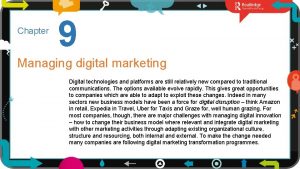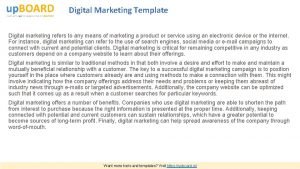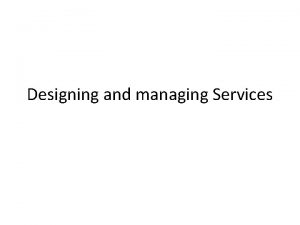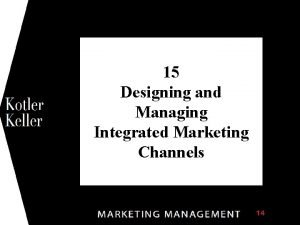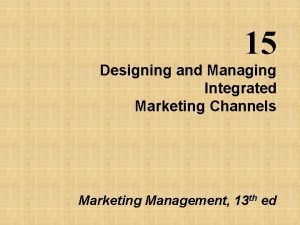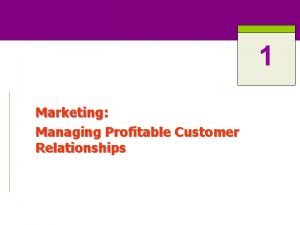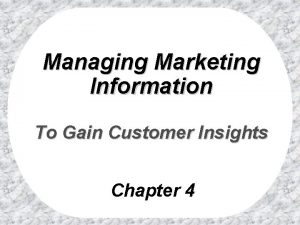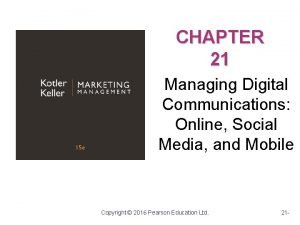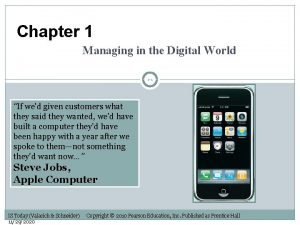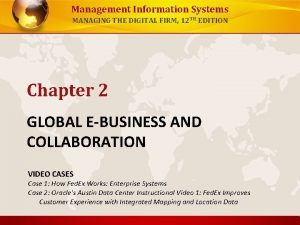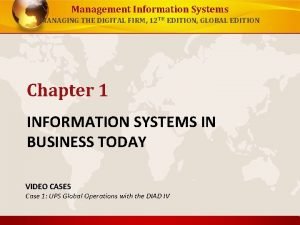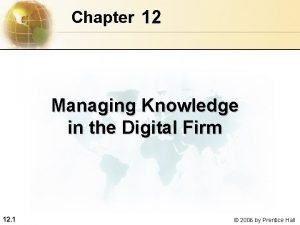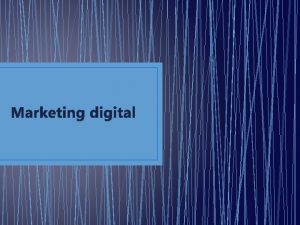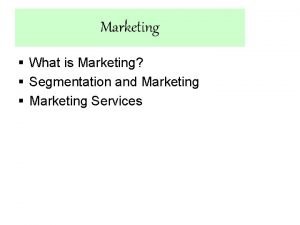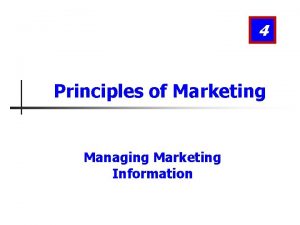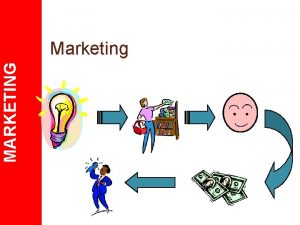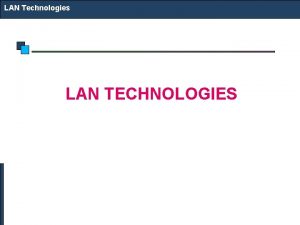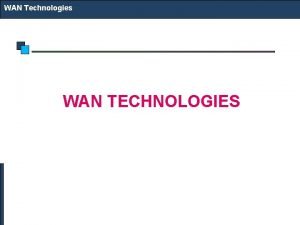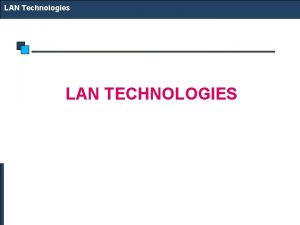Chapter 9 Managing digital marketing Digital technologies and




























- Slides: 28

Chapter 9 Managing digital marketing Digital technologies and platforms are still relatively new compared to traditional communications. The options available evolve rapidly. This gives great opportunities to companies which are able to adapt to exploit these changes. Indeed in many sectors new business models have been a force for digital disruption – think Amazon in retail, Expedia in Travel, Uber for Taxis and Graze for, well human grazing. For most companies, though, there are major challenges with managing digital innovation – how to change their business model where relevant and integrate digital marketing with other marketing activities through adapting existing organizational culture, structure and resourcing, both internal and external. To make the change needed many companies are following digital marketing transformation programmes. 1

9. 1 Introduction Managing digital marketing requires a constant review of new digital marketing opportunities. A major transformation to digital business and social business in organizations is needed to fully implement these new capabilities. 2

9. 2 Transformation to digital businesses Digital business describes how technology can transform key business processes out of the old value chain and into new, dynamic, value networks as part of digital disruption. Started with the purchase of raw materials. Moved to the production of goods and services, their distribution, marketing, sales and after-sales services. Reshuffled the sequence so that customers, distributors and partners are more involved as the business integrates into a flexible, fastermoving, customer-driven extended network of online partners Many businesses face challenge in these areas: Chaffey (2016) • • Planning Organisational capabilities Integration of digital channels into marketing Digital transformation 3

9. 2 Transformation to digital businesses 4

9. 2 Transformation to digital businesses E-commerce All electronically mediated transactions between an organization and any third party it deals with. 5

9. 2 Transformation to digital businesses • Buy-side digital business B 2 B – buying raw materials and/or services The business’ extranet is used to open-up certain aspects of the business (applications and data) to an exclusive audience of carefully selected suppliers. • In-side digital business B 2 E – Business to Employee Involves internal processes and communications. The intranet empowers employees by opening up access to key information and applications. • Sell-side digital business Involves processes and applications that help selling to and service customers. CRM and sellingchain management applications are commonly used. The extranet or the Virtual Private Network (VPN) provides exclusive use to strategic intermediary partners such as distributors and also to key account or registered customers. 6

9. 3 Creating the social business through implementing social CRM Social business is the next step in the overall evolution of business. As our global network of people becomes more instrumented, interconnected and intelligent, dramatic shifts are taking place. The ways in which people interact, relationships form, decisions are made, work is accomplished and goods are purchased are fundamentally changing. IBM (no date) 7

9. 3 Creating the social business through implementing social CRM A social CRM strategy can be developed by rewriting and prioritizing options in each of these six business applications: 1. 2. 3. 4. 5. 6. Marketing Sales Service and support Innovation Collaboration Customer experience Organizations create online communities, social networks and collaborative groups • Collaborative design tools • Crowdsourcing/ open innovation 8

9. 3 Creating the social business through implementing social CRM 9

9. 4 The endless journey – reviewing digital marketing capabilities Capturing maturity models • Shows the position of a company on its journey to digital business or social business • Through reviewing and benchmarking, a roadmap for future implementation can be developed 10

9. 4 The endless journey – reviewing digital marketing capabilities 11

9. 5 Budgeting for digital marketing Achieving the best balance between traffic-building and other digital marketing activities Key marketing costs: - Creating the user experience - Ongoing content creation and optimization - Traffic building on reach, covering the paid, owned and earned media Selecting the best communications mix - CPA - Volume - conversion - Branding impact - Flexibility - Frequency - Risk Balance between online and offline marketing Percentage of sales that are informed or completed online Balance of campaign and continuous traffic building 12

9. 6 Making the business case for digital marketing investment Types of digital investment decision • • • Media investment Agency resource Internal resource Capital expenditure (Cap. Ex) Operational expenditure (Op. Ex) Different digital marketing activities 13

9. 6 Making the business case for digital marketing investment Methods of justifying investment • • Prove value through tests Piggy backing Improve the quality of your data analysis Return-on-investments models Competitor and industry benchmarking Optimization Market research studies Forward planning 14

9. 6 Making the business case for digital marketing investment 15

9. 7 Selecting the right suppliers for digital marketing Choosing the level and type of marketing expertise: • Strategy • Market research and analysis • Campaign creative assets • Asset and content development • Campaign execution • Infrastructure Options for selecting a digital marketing agency: 1. Full-service digital agency 2. Specialist digital agency 3. Traditional agency 4. In-house resource 16

9. 8 Change management to digital transformation Main change levels required 1. Market and business model 2. Business process 3. Organizational structure, culture and staff responsibilities 4. Technology infrastructure changes 17

9. 8 Change management to digital transformation 18

9. 8 Change management to digital transformation 19

9. 8 Change management to digital transformation 20

9. 8 Change management to digital transformation Reasons for resistance to change Kotter & Schlesinger (1979) • Parochial self-interest • Lack of trust • Different evaluation of the benefits and costs likely to result from change • Low tolerance of change, perhaps as a result of culture or previous exposure to change Strategic agility Capability to innovate and gain competitive advantage by monitoring changes within an organization’s marketplace, and then to efficiently evaluate alternative strategies and then select, review and implement appropriate candidate strategies. 21

9. 9 Measuring and optimizing digital marketing with digital analytics Web analytics that improve digital marketing • Referring sites • Referral time • Search engine keywords • Conversion rates • Stickiness • Repeat visits Customer feedback tools • Website feedback tools • Site user intent – satisfaction surveys • Crowdsourcing product opinion softwares • Simple page or concept feedback tools • General online survey tools A/B and multivariate testing 22

9. 9 Measuring and optimizing digital marketing with digital analytics 23

9. 10 Automation Improves digital marketing efficiency It takes modelling and optimization to another level, where human intervention is minimized 1. Pay Per Click 2. Creative optimization 3. Web service delivery 4. Automation of marketing messages 24

9. 11 Implementing new systems Prototyping • • • Rapid Simple Iterative Incremental User-centred Change management Siebel (2003) 1. Compensation and rewards 2. Boss’ behaviour 3. Policies and processes 4. Training 5. Communication 6. Organizational structure 25

9. 11 Managing data quality 1. Accuracy Main attributes of data quality 2. Completeness 3. Validity 4. Consistency 26

9. 12 Digital business security threats • • • Credit-card fraud Distributed denial of service Cyber graffiti Botnets or alien computer control Chat room undesirables • Intellectual property theft • Competitive information • Anything that damages your data can have huge legal implications Digital business security solutions • • Contracts Trend and exception monitoring Public key technology and cryptography Intrusion detection routines • Virus scanners • Audit trails • Back-up 27

Chapter summary • Digital marketers need to be adept at change management. Identifying relevant changes, making the case for change and then implementing change within an organization. • To manage digital marketing in a medium-sized to large organization, the integration with digital business services such as intranets and extranets need to be managed also through collaboration with colleagues. • Many companies are now considering social business and social CRM as a way to improve collaboration internally and to harness the insights from customer and partner interactions. • To help develop a roadmap of enhancements to marketing, capability assessment of the overall digital strategy and individual channels is a useful approach. • To help make the case for digital marketing, quantitative models such as conversion budget models and lifetime value models are recommended. • Depending on the type of business and the competence of competitors, different supplier arrangements can take care of management communications channels or SEO. • Great tools existing for optimizing online customer experiences using techniques such as web analytics, A/B and multivariate testing. • Tools are available for running automation. • The digital marketer should ensure data quality, privacy and security. 28
 Managing digital marketing
Managing digital marketing Digital marketing marketing refers
Digital marketing marketing refers Marketing simulation: managing segments and customers v3
Marketing simulation: managing segments and customers v3 Nature and characteristics of service marketing
Nature and characteristics of service marketing Designing and managing integrated marketing communications
Designing and managing integrated marketing communications Strategic profitability analysis
Strategic profitability analysis Designing and managing integrated marketing communications
Designing and managing integrated marketing communications High value deal seekers
High value deal seekers Integrated marketing channel system
Integrated marketing channel system Managing integrated marketing communications
Managing integrated marketing communications Designing and managing integrated marketing communications
Designing and managing integrated marketing communications Designing and managing integrated marketing channels
Designing and managing integrated marketing channels Healthtech ecosystem
Healthtech ecosystem Marketing information and customer insights are
Marketing information and customer insights are Managing the marketing effort
Managing the marketing effort Consumers needs and wants are fulfilled through
Consumers needs and wants are fulfilled through Managing a holistic marketing organization for the long run
Managing a holistic marketing organization for the long run Importance of rest
Importance of rest Managing marketing information
Managing marketing information Digital gem technologies
Digital gem technologies Victorian curriculum progression points
Victorian curriculum progression points Managing digital communications
Managing digital communications Managing in a digital world
Managing in a digital world Managing in a digital world
Managing in a digital world Management information system managing the digital firm
Management information system managing the digital firm Management information systems managing the digital firm
Management information systems managing the digital firm Finance in a digital world
Finance in a digital world Managing the digital firm
Managing the digital firm Managing knowledge in the digital firm
Managing knowledge in the digital firm
